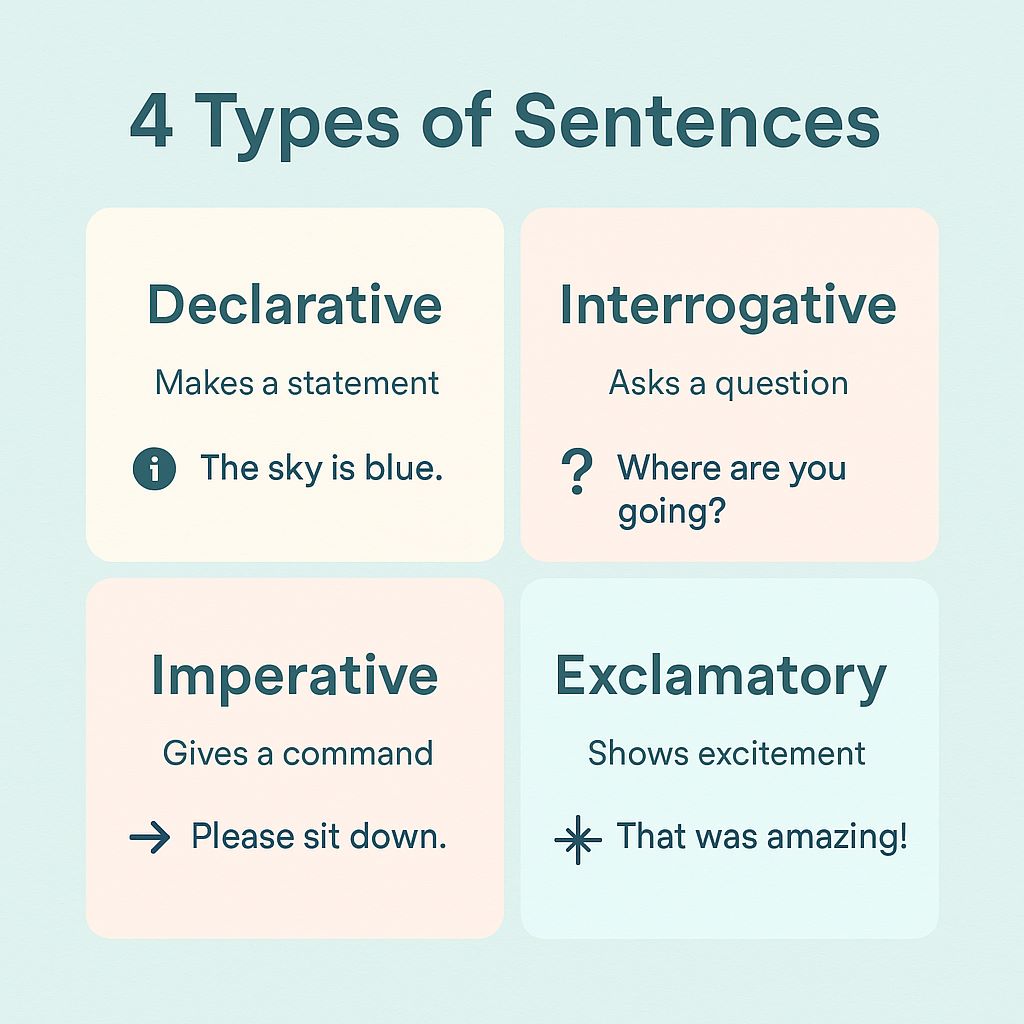4 Types of Sentences With Examples
Writing doesn't have to be complicated. In this guide, we'll show you the four basic types of sentences and how to use them. Whether you're writing emails, essays, or stories, knowing these basics will help you write better.
Ever read something and felt like you couldn’t stop? That’s the power of using 4 different types of sentences. Some writers know how to mix things up.
Others use the same kind of sentence again and again, and that makes their writing boring.
In this guide, I’ll show you how to use 8 types of sentences.
Once you learn these, your writing will feel more alive and much easier to understand. And the best part? You can start using them today.
Also, I’ll share how tools like AI chat, a paragraph generator, and even an AI humanizer can help you write in a better and more natural way.
How Many Sentence Types Are There?
There are 8 sentence types in total. We group them in two ways: by what they do (their function) and by how they’re built (their structure).
According to Function
There are 4 sentence types based on function:
“Declarative sentences” — These tell you something.
“Interrogative sentences” — These ask a question.
“Imperative sentences” — These give a command or request.
“Exclamatory sentences” — These show strong feelings.
According to Structure
There are also 4 sentence types based on structure:
“Simple sentences” — One complete idea.
“Compound sentences” — Two or more ideas joined together.
“Complex sentences” — One main idea and one or more smaller ideas.
“Compound-complex sentences” — A mix of both compound and complex ideas.
Some sentences fit into both groups. For example, a question can be simple, complex, or compound.
Sentence Types by Function
Let’s break them down with simple examples and uses.
“Interrogative Sentences”
These are questions. They end with a question mark. For example:
“Where are my keys?”
“Did you eat lunch?”
“Can she come with us?”
Tools like AI chat can help you practice asking better questions. Try asking it something like, “Can you give me an interrogative sentence?”
“Imperative Sentences”
These are commands or instructions. Most of the time, the subject "you" is hidden. For example:
“Close the door.”
“Try the cookies.”
“Don’t shout.”
An AI humanizer can help turn these into more polite forms if you’re writing emails or giving instructions professionally.
“Declarative Sentences”
These are regular statements. They tell a fact or give information. For example:
“It is sunny today.”
“I enjoy painting.”
“She works from home.”
Declarative sentences are great for starting a paragraph. If you’re using a paragraph generator, try starting with a declarative sentence to set the topic.
“Exclamatory Sentences”
These show feelings like joy, surprise, or anger. They end with an exclamation mark. For example:
“What a great show!”
“I can't believe it!”
“Wow!”
They bring emotion into your writing, and you’ll often see them in stories or personal blogs.
Sentence Types by Structure
Now let’s look at how sentences are built.
“Simple Sentences”
These have just one complete thought. For example:
“The baby is sleeping.”
“Tom plays football.”
“They danced.”
Use simple sentences when you want to keep things clear. Short sentences can have a big impact.
“Compound Sentences”
These have two or more complete thoughts, usually joined by words like “and,” “but,” or “so.” For example:
“I was tired, but I kept working.”
“She likes tea, and he prefers coffee.”
A tool that helps you learn the types of paragraphs can show you how compound sentences help build stronger body paragraphs.
“Complex Sentences”
These have one main idea and at least one smaller idea. For example:
“Although it was late, she kept reading.”
“Because it was raining, we stayed inside.”
“When I got there, the party had started.”
This is where sentences that start with however also fit in. “However” adds contrast. For example:
“She loves summer. However, she hates the heat.”
You can play around with these sentence starters using a paragraph generator to see how your ideas flow.
“Compound-Complex Sentences”
These are a mix of both compound and complex. They sound tricky but are easy once you practice. For example:
“While I cooked dinner, the kids watched TV, and my partner cleaned the house.”
“If you study hard, you will pass the exam, but you’ll need to stay focused.”
These are great for storytelling and formal writing because they let you explain a lot in just one sentence.
Wrapping It All Up
So, what did we learn?
There are 8 main types of sentences. Four by function. Four by structure.
Mixing them makes your writing more exciting and easier to read. Whether you’re writing an email, a story, or a blog post, learning these sentence types is a huge help.
You don’t need to memorize everything at once. Use tools like AI chat to ask questions. Try out a paragraph generator to practice writing. And use an AI humanizer if your writing sounds too stiff.
With time, you’ll get better—and your readers will notice.
FAQs
How many sentence types are there in English?
There are eight main types — four by function and four by structure.
What are the most common sentence types used in paragraphs?
Simple, compound, and complex sentences are most often used when writing paragraphs.
Can a sentence start with ‘however’?
Yes! ‘However’ shows contrast. It usually comes after a period or semicolon and is followed by a comma.
Do all good writers use different sentence types?
Yes. Mixing sentence types helps make writing clear, emotional, and fun to read.

